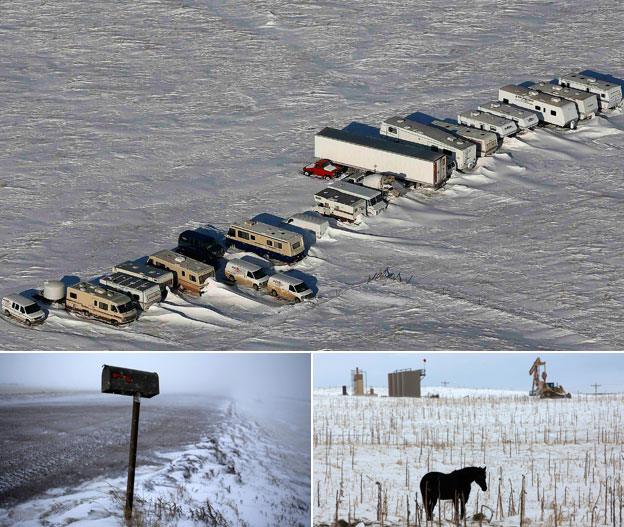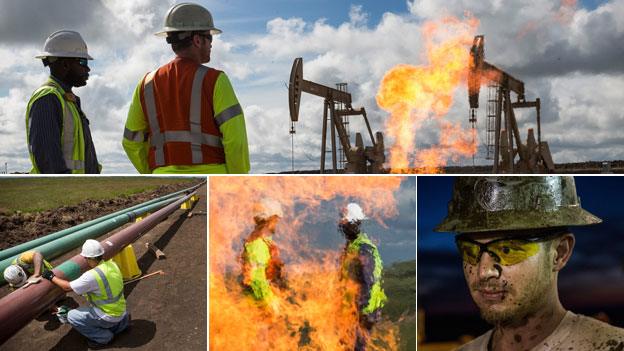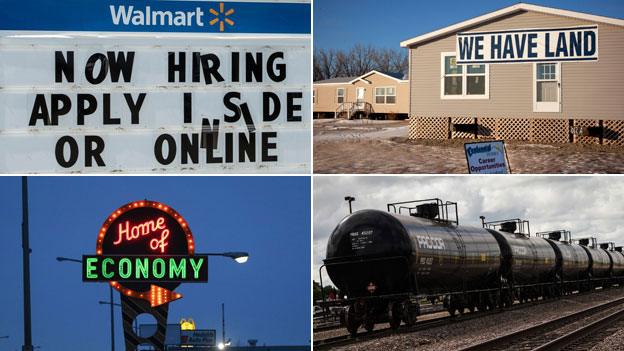North Dakota oil boom: American Dream on ice
- Published
It's a busy Monday night at Whispers strip bar in the oil boomtown of Williston, North Dakota.
A man in overalls drains his glass before showering money on a pole dancer.
By the side of the stage, a half-nude woman is building a miniature house out of folded dollar bills.
Strippers can earn $2,500 (£1,500) per shift here, says a bouncer.
But one employee, who goes by the name of Alexis, isn't feeling especially motivated tonight.
She's wearing a woolly sweater because whenever the front door opens an Arctic draught slashes at the pleather booths. It's -31C (-24F) outside.
"I do this work back in Illinois," says the mother of two, sipping a Sprite.
"But the men here are 100% worse. It's horrible. They're animals.
"I've only been here a week, but I'm done with Williston. I'm going home next weekend."
Fortunately for Whispers, there's no lack of applicants eager to take her place.
Exotic dancers are flocking here from as far away as Russia for the same reason as everyone else - to make their fortune in a place known as Kuwait on the Prairie.
Williston was once a humble ranching community tucked away near the Canadian border in one of the remotest US states.
But a sea of oil and gas beneath the region's farmland, and the hydraulic fracking technology that began to unlock it in 2006, has turned this small city into the wellhead of the North American energy boom.
I found myself stuck in a traffic jam on the drive into Williston. It was rush hour - at 23:00 on a Sunday.
Supply lorries were rumbling for several miles through heavy snow over a road of ice.
Williston has a jobless rate of just 0.3%, thought to be the lowest in the nation.
Signs everywhere in the Oil Patch proclaim: "Now Hiring".
With no college degree and little experience, it's possible to land a job with a six-figure salary as a wildcatter, living in a "man camp".
Walmart, for example, is paying shelf stackers $19.28 (£12) an hour - more than double its average national wage.
But wages struggle to keep pace with soaring rents.
And not everyone in this frozen frontier can find work.
Hundreds of itinerant job-hunters end up sleeping rough in sub-zero temperatures every year.
Kenneth Winter, 43, left the California sunshine for Williston two years ago, only to find himself homeless and unemployed.
He ended up living in his Chevy Tahoe for 10 months in the car parks of Walmart and Pizza Hut.
The manager of a fast-food chain took pity on his plight and used to give him free meals.
"It was minus 30 degrees [Fahrenheit]," recalls Winter, who now has a job and a place to live. "I barely had the heat in my car to keep me warm. I came close to ending it, I did. I had thoughts of wanting to just end my life."
.gif)
Crime has risen sharply in the area, Williams County Sheriff Scott Busching acknowledges.
But he puts it down to urban growing pains.
Williston's population is estimated to have more than tripled from 12,000 residents half a decade ago.
The number of fatal road collisions, drug arrests, physical and sexual assaults have all surged, says Sheriff Busching.
"Bar fights, yes, they're way up," adds the lawman. "Seven in the morning is somebody's happy hour here.
"It can be just as busy on a Tuesday afternoon as it is on a Friday night. It's going all the time. This place hums."
It recently took four of his officers to restrain a meth-high roustabout who went berserk and began smashing up oil machinery.

Not everyone prospers in this frozen frontier
Domestic violence is also on the rise. And the city's chronic housing shortage means that many victims have little choice but to stay with their abusers.
Williston's Family Crisis Shelter says it is helping more and more battered women with injuries ranging from fractured eye sockets to strangulation marks.
The male-to-female ratio here is widely estimated to be about 10:1. Many women do not feel safe walking the streets alone.
Bailey Moreland, 25, a barista at Meg-A-Latte coffee shop, carries a stun gun everywhere she goes.

Williston's boom has prompted comparisons with Alaska's Klondike Gold Rush of 1896-99
She has had men hit on her even after she points out that she is not only heavily pregnant but happily engaged.
"Being in a bar, going to the gas station, walking on the street, you'll get hooted and hollered at," she says.
"I don't make eye contact with anybody."
But for many in a nation still bruised by recession, the modern-day gold rush here is a symbol of America's genius for reinvention.
One of them is Carl Trudel, a 37-year-old maintenance man at the Fox Run motorhome park on the city outskirts.
He sold everything he had after the property market went bust in Florida to migrate north in 2012.
The singleton's loyal companion in the trailer he calls home is his dog, Dooley. He lavishes affection on the Staffordshire terrier.
Living in Williston is "not easy" and can be "very lonely", says Trudel.
Yet despite its rowdy bars, runaway prices, long queues at the laundrette or petrol station, and the often-bare supermarket shelves, he seems content.
"If you have the ambition, the plan, the skills, you will make it here," insists Trudel. "It's really up to you.
"But absolutely the American dream is here. That's why I'm here. And so far it's happening. Absolutely."

Williston Police Department received about 4,000 calls in 2005 - that number has now quadrupled

The Bakken region around Williston has 10,000 oil wells, a number expected to rise six-fold in the next two decades

Williston's two previous oil booms - in the 1950s and 1980s - turned out to be short-lived, but the technology of hydraulic fracking appears to have changed the game this time
Follow @BBCNewsMagazine, external on Twitter and on Facebook, external